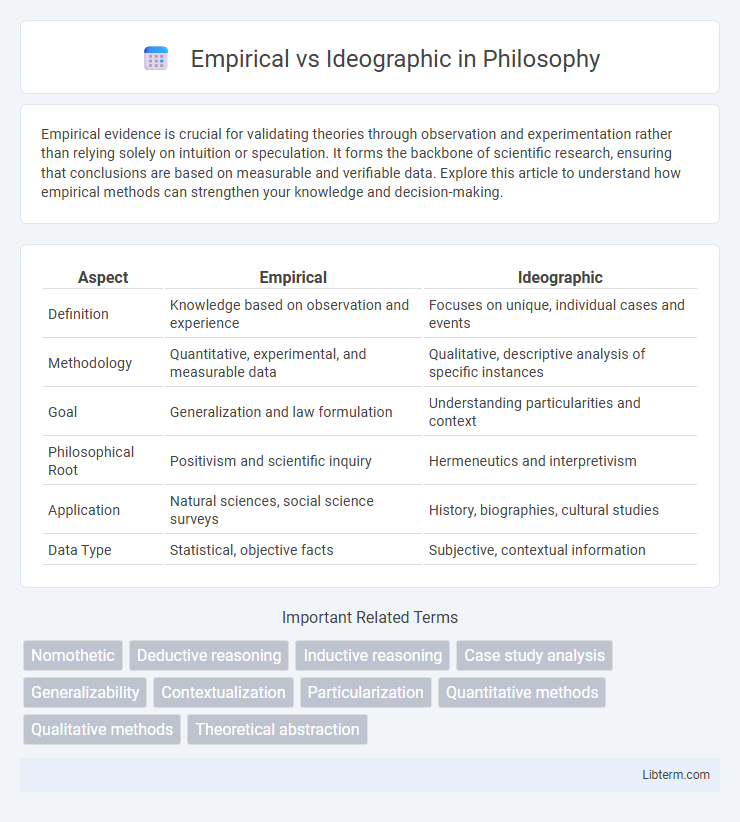Empirical evidence is crucial for validating theories through observation and experimentation rather than relying solely on intuition or speculation. It forms the backbone of scientific research, ensuring that conclusions are based on measurable and verifiable data. Explore this article to understand how empirical methods can strengthen your knowledge and decision-making.
Table of Comparison
| Aspect | Empirical | Ideographic |
|---|---|---|
| Definition | Knowledge based on observation and experience | Focuses on unique, individual cases and events |
| Methodology | Quantitative, experimental, and measurable data | Qualitative, descriptive analysis of specific instances |
| Goal | Generalization and law formulation | Understanding particularities and context |
| Philosophical Root | Positivism and scientific inquiry | Hermeneutics and interpretivism |
| Application | Natural sciences, social science surveys | History, biographies, cultural studies |
| Data Type | Statistical, objective facts | Subjective, contextual information |
Introduction to Empirical and Ideographic Approaches
Empirical approaches rely on observation, experimentation, and measurable evidence to understand phenomena, emphasizing quantifiable data and reproducibility. Ideographic approaches prioritize the detailed, contextual analysis of individual cases or events, focusing on unique, subjective experiences and historical specificity. These contrasting methodologies underscore the distinction between generalizable scientific laws and in-depth qualitative understanding in research.
Defining Empirical Research
Empirical research involves the systematic collection and analysis of observable and measurable data to generate knowledge based on evidence rather than theory or pure logic. This approach emphasizes the use of experiments, surveys, and observations to test hypotheses and validate findings through reproducibility and objectivity. Empirical research contrasts with ideographic methods by prioritizing generalizability and statistical analysis over in-depth, case-specific understanding.
Understanding Ideographic Methodology
Ideographic methodology centers on in-depth analysis of individual cases or events, emphasizing unique, context-specific insights rather than broad generalizations. It prioritizes qualitative data, rich descriptions, and subjective interpretations to capture the complexity of human experiences. This approach contrasts with empirical methods, which typically seek measurable, replicable results across larger populations.
Historical Origins of Both Approaches
Empirical approaches originated in the 17th-century scientific revolution, emphasizing observation, experimentation, and measurable evidence to understand phenomena. Ideographic methods trace back to early historical and humanistic studies in the 19th century, focusing on the detailed examination of unique, context-specific events or individuals. The divergence stems from empirical roots in natural sciences and ideographic origins in qualitative, interpretive traditions.
Key Differences Between Empirical and Ideographic Methods
Empirical methods rely on measurable data and statistical analysis to identify general patterns, emphasizing objectivity and reproducibility in research. Ideographic methods focus on detailed, context-rich examination of individual cases, prioritizing depth over breadth to understand unique phenomena. Key differences include the scope of analysis--empirical seeks universal laws, ideographic targets specific insights--and the nature of data--quantitative versus qualitative.
Applications in Social Sciences
Empirical methods in social sciences prioritize quantitative data collection and statistical analysis to identify generalizable patterns across populations, facilitating predictions and theory testing. Ideographic approaches emphasize in-depth qualitative analysis of unique cases or individual experiences, offering detailed insights into complex social phenomena and contextual variations. Combining empirical and ideographic methods enhances understanding by integrating broad trends with rich, contextualized interpretations in fields such as sociology, psychology, and anthropology.
Strengths and Limitations of Empirical Research
Empirical research excels in generating measurable and observable data, allowing for replication and objective validation across diverse populations, which strengthens its reliability and generalizability. However, its limitation lies in potential biases from sampling errors, measurement inaccuracies, and the reductionist approach that may overlook complex, context-specific human experiences. The reliance on quantitative methods can obscure nuanced insights that idiographic approaches, focused on individual cases, better capture, highlighting a trade-off between breadth and depth in knowledge production.
Strengths and Limitations of Ideographic Research
Ideographic research excels in providing in-depth, context-rich insights by focusing on individual cases, allowing for detailed understanding of unique experiences and complex phenomena. Its strength lies in capturing the nuances and subjective meanings that quantitative methods may overlook, making it valuable for exploring rare or intricate issues. However, ideographic research faces limitations in generalizability, as findings are often specific to particular individuals or cases, and it can be time-consuming and less replicable compared to empirical, nomothetic approaches.
Integrating Empirical and Ideographic Approaches
Integrating empirical and ideographic approaches enhances psychological research by combining quantitative data with in-depth analysis of individual cases. Empirical methods provide statistically valid patterns across populations, while ideographic approaches uncover unique personal experiences invisible to broad surveys. This integration fosters a holistic understanding of human behavior, improving both generalizability and personalized insights.
Conclusion: Choosing the Right Method for Your Study
Selecting the appropriate research method depends on the study's goals and context; empirical methods prioritize measurable, quantitative data ideal for generalizable results, while ideographic methods emphasize detailed, qualitative insights suited for understanding unique cases. Researchers should assess whether their objective is to identify broad patterns or to explore in-depth individual experiences, guiding the choice between statistical analysis and rich narrative description. Balancing empirical rigor with ideographic depth ensures the selection of a method that aligns with the research questions and enhances the validity of conclusions.
Empirical Infographic

 libterm.com
libterm.com